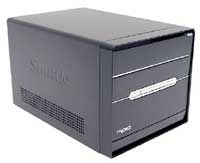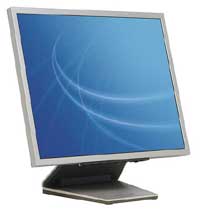Mid-Range SFF Gaming System
One area that we didn't address yet is the potential to go with a small form factor (SFF) system. This especially makes sense for those who attend LAN parties, not to mention the college students that lack space for a large system in their dorm rooms. Many people think that SFF systems are really expensive, but that's not necessarily true. All told, the cost of going with a SFF setup is about $50 more than going with a standard desktop system. There are drawbacks, but first, let's list our SFF configuration, again using an Athlon 64.
| Mid-Range SFF AMD Athlon 64 System |
| Hardware |
Recommended Component |
Price |
| Processor |
AMD Athlon 64 3500+ 512K 2.2 GHz (939) 90nm |
285 |
| Memory |
Mushkin Dual Pack 2x512 PC3200 2.5-3-3 |
159 |
| Video Card |
Albatron GeFORCE 6800 GT 256MB GDDR3 |
374 |
| Hard Drive |
Seagate 160GB SATA 7200RPM 8MB Model ST3160023AS |
93 |
| Optical Drive |
NEC DVD+/-RW Drive Model 3500A |
72 |
| SFF Case |
Shuttle XPC SN95G5 (AMD socket 939) |
299 |
| Display |
Samsung 172X 17 LCD |
429 |
| Speakers |
Logitech Z-640 5.1 |
52 |
| Keyboard |
Logitech Internet Keyboard |
17 |
| Mouse |
Microsoft IntelliMouse Optical |
24 |
| Bottom Line |
|
1804 |

Click to enlarge. |
The total price of our SFF configuration ends up being almost $300 more than the Mid-Range system, but there are reasons for this. We have included a 17" LCD with our SFF recommendation, which is the lion's share of the price increase. After all, what's the point of getting a space-saving, portable case if you're going to pair it with a bulky CRT? That adds an extra $200 to the price, so if you disagree and feel that CRTs and SFFs can peacefully coexist, you can put together a Mid-Range SFF system for $1600. As with the high-end setup, we strongly recommend that anyone looking for a quality LCD get a model that had a DVI-D interface. Unfortunately, one knock against the Samsung 172X is that it is an 18-bit display, which uses dithering/interpolation to "reproduce" 24-bit color. This doesn't matter too much in games, and the 12 ms response time convinces us to go with it anyway, but we're not entirely happy with the options in the 17" LCD segment. Besides the display, remember that a SFF case includes the motherboard and a custom heatsink for the CPU in addition to the case and power supply. So, the $300 cost of the Shuttle XPC takes the place of about $225 of desktop hardware - $250 if you want an aftermarket HSF for your system.

Click to enlarge. |
The one thing that you do sacrifice with a SFF is expansion options. Where most desktop cases can support three or four 5.25" drives, two external 3.5" bays, and three or more internal 3.5" hard drives, the Shuttle XPC that we have used is limited to one 5.25" drive and one 3.5" drive externally, along with one 3.5" internal mount for your hard drive. It is also limited to one AGP slot and one PCI slot, but with all of the included features, the lack of PCI slots is not likely to be an issue. RAM expansion options have been cut back to two DIMM sockets, so even with 1 GB DIMMs, you would max out at 2 GB of RAM. None of these issues are deal-breakers, however, and when paired with a 6800 or X800 graphics card, you have a lot of performance packed into a small, quiet chassis.
We have only included a SFF recommendation for a socket 939 Athlon system, but you could do the same with any other platform. Nearly every motherboard manufacturer has at least one SFF system available, and usually they have several. If you don't upgrade components frequently, SFF cases can be a convenient replacement of the standard "boring" home or office computer.












70 Comments
View All Comments
benk - Monday, November 22, 2004 - link
The Dell 2001FP is listed at 799 and is often on sale for well below 700.Swaid - Monday, November 22, 2004 - link
Illissius -I was just about to suggest that. The Epox motherboard is a much better "buy" then the Chaintech now.
Illissius - Monday, November 22, 2004 - link
I agree with nearly all the choices, which can't be said for most other buying guides I've read :)My one suggestion is that the EPoX 8KDA3J costs nearly the same as the Chaintech VNF3-250, and has more functionality -- namely, it uses the 250Gb chipset.
kherman - Monday, November 22, 2004 - link
AGP:Anyone wondering aobut when it will be phased out, just look back to old PCI video cards. Took about 1-2 years for manufacturers to drop AGP support altogether. It's a supply demand issue.
As for mobo's I'd expect to see new mobo's w/AGP for atleast a year more. Some people iwll be using those older video cards after all. Also, multiple PCI-X slots are the goal and if I understand correctly, PCI altogether will be dropped, menaing network and sound cards will also need a PCI-X home.
Anyways...my 2 cents.
kherman - Monday, November 22, 2004 - link
How about RAID 5 for the "fully employed" system? Would be redundant and should give slightly faster load times ;)kherman - Monday, November 22, 2004 - link
"Budget Gaming System, Part Two"IMHO: Keep the 2800+ part and spend that extra $50 on a better video card. That will give better frame rates, IMO of course.
JarredWalton - Monday, November 22, 2004 - link
I've heard conflicting reports about the quality of gaming on the Dell 2001FP. Some people love it, and others think it's good but perhaps not great. The price on it is also subject to quite a bit of variation. Right now, I believe it's on sale for about the same as the Viewsonic, while "normally" it might be $1000 plus shipping. I have not actually used one in person, so I can't really comment on interpolation quality, but of the LCDs that I have used, I have yet to see one that offers interpolation of such a quality that I wouldn't hesitate to recommend it. Opinions on that, of course, differ.The same goes for the wireless mouse. Some people swear by the MX510. I've tried it, and I simply did not like it. The Microsoft wireless mice I've tried were even worse, however. Anyway, the choice of mouse is very personal. I really like the standard MS Optical five button. It's light and accurate enough that I don't have any complaints. Even with an unlimited budget, I would still buy that same mouse for my own use. I *could* go out and try numerous other mice, but I'm just not that concerned with that one peripheral. If you are, more power to you! :)
MiLLeRBoY - Monday, November 22, 2004 - link
Also, for the High-End Gaming, check out the new the Logitech Z-5500 Digital speakers. It's just a revamped version of the Z-680's design as well as adding more power. The subwoofer is noticeably larger than the former though. The retail price is $400.MiLLeRBoY - Monday, November 22, 2004 - link
DEMO24 - I have the 20.1" Dell 2001FP and it only has a 16ms response time. However, I don't see ghosting when playing games. I also play my games at 1024x768 with 4xAA when the LCD's native resolution is 1600x1200. The image interpolation is great, it doesn't look horrible even at 1280x1024 or 1024x768. And the price is around the same as the ViewSonic VP912B. However, I probably wouldn't mind using any of those two LCDs, they're both great.xsilver - Monday, November 22, 2004 - link
?? min 18A on 12v rail -- crap my PSU doesn't have that... will it not run a AMDs939? (15A -- enhance brand, respectable, heavy)